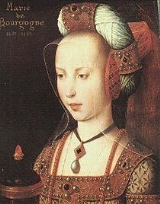
Mary of Burgundy
Encyclopedia
Mary of Burgundy ruled the Burgundian territories in Low Countries
and was suo jure
Duchess of Burgundy
from 1477 until her death. As the only child of Charles the Bold, Duke of Burgundy, and his wife Isabella of Bourbon
, she was the heiress to the vast Burgundian domains in France and the Low Countries upon her father's death in the Battle of Nancy
on 5 January 1477.
, at the ducal castle of Coudenberg
, to Charles the Bold, Count of Charolais, and his wife, Isabella of Bourbon
. Her birth, according to the court chronicler, Georges Chastellain
, was attended by a clap of thunder ringing from the otherwise clear twilight sky. Her godfather was Louis, Dauphin of France
, in exile in Burgundy at that time; he named her for his mother, Marie of Anjou
. Reactions to the child were mixed: the baby's grandfather, Duke Philip the Good, was unimpressed, and "chose not to attend the [Baptism] as it was only for a girl"; the grandmother, Isabella of Portugal, was simply delighted at the birth of a granddaughter.
. As the only child of Charles the Bold, Mary was heiress presumptive to a vast and wealthy domain, made up of the Duchy of Burgundy
, the Free County of Burgundy, and the majority of the Low Countries
, and her hand was eagerly sought by a number of princes. The first proposal was received by her father when she was only five years old, to marry the future King Ferdinand II of Aragon
. Later the younger brother of Louis XI, Charles, Duke of Berry
, made an approach, to the intense annoyance of his brother the King, who attempted to prevent the necessary papal dispensation for consanguinity
.
 As soon as Louis produced a male heir who survived infancy, the future King Charles VIII of France
As soon as Louis produced a male heir who survived infancy, the future King Charles VIII of France
, Louis wanted his son to be the one to marry Mary, despite his son being thirteen years younger than Mary. Nicholas I, Duke of Lorraine
, was a few years older than Mary, and his duchy lay alongside Burgundian territory, but his plan to combine his territory with hers was frustrated by his death in battle in 1473.
on 5 January 1477. King Louis XI of France seized the opportunity afforded by his rival's defeat and death to attempt take possession of the Duchy of Burgundy proper, and also of Franche-Comté
, Picardy
and Artois
.
The King was anxious that Mary should marry his son Charles and thus secure the inheritance of the Low Countries
for his heirs, by force of arms if necessary. Mary, advised by her stepmother, Margaret of York
, distrusted Louis, declined the French alliance, and turned to her Netherland subjects for help. Sensing her weakness, they gave her their help only at the price of great concessions.
on the occasion of her formal recognition, known as the Joyous Entry
, as Charles' heir, she was compelled to sign a charter of rights, called the Great Privilege
. Under this agreement, the provinces and towns of Flanders
, Brabant
, Hainaut
, and Holland
recovered all the local and communal rights which had been abolished by the decrees of the dukes of Burgundy in their efforts to create a centralized state on the French model out of their separate holdings in the Low Countries. In particular, the Parliament of Mechelen (established formally by Charles the Bold in 1470) was abolished and replaced with the pre-existing authority of the Parliament of Paris, which was considered an amenable counterweight to the encroaching, if informal, centralization undertaken by both Charles the Bold and Philip the Good. The Duchess also had to undertake not to declare war, make peace, or raise taxes without the consent of the States, and to employ only native residents in official posts.
Such was the hatred of the people for the old regime that two of her father's influential councilors, the Chancellor Hugonet and the Sire d'Humbercourt, having been discovered in correspondence with the King of France, were executed at Ghent
despite the tears and entreaties of the Duchess.
, who became her co-ruler. The marriage took place at Ghent
on 18 August 1477. The event initiated two centuries of contention between France and the Habsburgs (later of Spain, then of Austria) for their possession, which climaxed in the War of the Spanish Succession
, 1701–1714.
In the Netherlands, affairs now went more smoothly, the French aggression was temporarily checked, and internal peace was in large measure restored.
.
Louis was swift to re-engage, and forced Maximilian to agree to the Treaty of Arras (1482)
by which Franche-Comté
and Artois
passed for a time to French rule, only to be regained by the Treaty of Senlis
(1493), which established peace in the Low Countries.
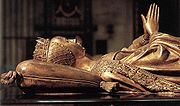 Three children had been the issue of her marriage, and her eldest son, Philip, succeeded to her dominions under the guardianship of his father.
Three children had been the issue of her marriage, and her eldest son, Philip, succeeded to her dominions under the guardianship of his father.
Her children were:
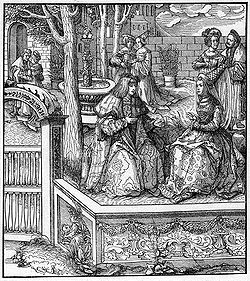
Low Countries
The Low Countries are the historical lands around the low-lying delta of the Rhine, Scheldt, and Meuse rivers, including the modern countries of Belgium, the Netherlands, Luxembourg and parts of northern France and western Germany....
and was suo jure
Suo jure
Suo jure is a Latin phrase meaning "in her [or his] own right".It is commonly encountered in the context of titles of nobility, especially in cases where a wife may hold a title in her own right rather than through her marriage....
Duchess of Burgundy
Duke of Burgundy
Duke of Burgundy was a title borne by the rulers of the Duchy of Burgundy, a small portion of traditional lands of Burgundians west of river Saône which in 843 was allotted to Charles the Bald's kingdom of West Franks...
from 1477 until her death. As the only child of Charles the Bold, Duke of Burgundy, and his wife Isabella of Bourbon
Isabella of Bourbon
Isabella of Bourbon, Countess of Charolais was the second wife of Charles the Bold, Count of Charolais and future Duke of Burgundy. She was a daughter of Charles I, Duke of Bourbon and Agnes of Burgundy, and the mother of Mary of Burgundy, heiress of Burgundy.-Life:Not much is known about her life...
, she was the heiress to the vast Burgundian domains in France and the Low Countries upon her father's death in the Battle of Nancy
Battle of Nancy
The Battle of Nancy was the final and decisive battle of the Burgundian Wars, fought outside the walls of Nancy on 5 January 1477 between Charles the Bold, Duke of Burgundy, and René II, Duke of Lorraine...
on 5 January 1477.
Early years
Mary of Burgundy was born in BrusselsBrussels
Brussels , officially the Brussels Region or Brussels-Capital Region , is the capital of Belgium and the de facto capital of the European Union...
, at the ducal castle of Coudenberg
Coudenberg
Coudenberg or Koudenberg is a small hill in Brussels where the Palace of Coudenberg was built.For nearly 700 years, the Castle and then the Palace of Coudenberg were the seat of government of the counts, dukes, archdukes, kings, emperors and governors who from the 11th century until its...
, to Charles the Bold, Count of Charolais, and his wife, Isabella of Bourbon
Isabella of Bourbon
Isabella of Bourbon, Countess of Charolais was the second wife of Charles the Bold, Count of Charolais and future Duke of Burgundy. She was a daughter of Charles I, Duke of Bourbon and Agnes of Burgundy, and the mother of Mary of Burgundy, heiress of Burgundy.-Life:Not much is known about her life...
. Her birth, according to the court chronicler, Georges Chastellain
Georges Chastellain
Georges Chastellain , Burgundian chronicler and poet, was a native of Aalst in Flanders. In spite of excessive partiality to the Duke of Burgundy, Chastellain's historical works are valuable for the accurate information they contain. As a poet he was famous among his contemporaries...
, was attended by a clap of thunder ringing from the otherwise clear twilight sky. Her godfather was Louis, Dauphin of France
Louis XI of France
Louis XI , called the Prudent , was the King of France from 1461 to 1483. He was the son of Charles VII of France and Mary of Anjou, a member of the House of Valois....
, in exile in Burgundy at that time; he named her for his mother, Marie of Anjou
Marie of Anjou
Marie of Anjou was the Queen consort of King Charles VII of France from 1422 to 1461. Her mother, Yolande of Aragon, played a leading role in the last phase of the Hundred Years' War.-Family:...
. Reactions to the child were mixed: the baby's grandfather, Duke Philip the Good, was unimpressed, and "chose not to attend the [Baptism] as it was only for a girl"; the grandmother, Isabella of Portugal, was simply delighted at the birth of a granddaughter.
Heiress presumptive
Philip the Good died in 1467, making his son Duke of Burgundy and his 10-year-old granddaughter heiress presumptiveHeir Presumptive
An heir presumptive or heiress presumptive is the person provisionally scheduled to inherit a throne, peerage, or other hereditary honour, but whose position can be displaced by the birth of an heir or heiress apparent or of a new heir presumptive with a better claim to the position in question...
. As the only child of Charles the Bold, Mary was heiress presumptive to a vast and wealthy domain, made up of the Duchy of Burgundy
Duchy of Burgundy
The Duchy of Burgundy , was heir to an ancient and prestigious reputation and a large division of the lands of the Second Kingdom of Burgundy and in its own right was one of the geographically larger ducal territories in the emergence of Early Modern Europe from Medieval Europe.Even in that...
, the Free County of Burgundy, and the majority of the Low Countries
Low Countries
The Low Countries are the historical lands around the low-lying delta of the Rhine, Scheldt, and Meuse rivers, including the modern countries of Belgium, the Netherlands, Luxembourg and parts of northern France and western Germany....
, and her hand was eagerly sought by a number of princes. The first proposal was received by her father when she was only five years old, to marry the future King Ferdinand II of Aragon
Ferdinand II of Aragon
Ferdinand the Catholic was King of Aragon , Sicily , Naples , Valencia, Sardinia, and Navarre, Count of Barcelona, jure uxoris King of Castile and then regent of that country also from 1508 to his death, in the name of...
. Later the younger brother of Louis XI, Charles, Duke of Berry
Charles de Valois, Duc de Berry
Charles de Valois, Duke of Berry was a son of Charles VII, King of France. He spent most of his life in conflict with his elder brother, King Louis XI of France.-Life:...
, made an approach, to the intense annoyance of his brother the King, who attempted to prevent the necessary papal dispensation for consanguinity
Consanguinity
Consanguinity refers to the property of being from the same kinship as another person. In that respect, consanguinity is the quality of being descended from the same ancestor as another person...
.

Charles VIII of France
Charles VIII, called the Affable, , was King of France from 1483 to his death in 1498. Charles was a member of the House of Valois...
, Louis wanted his son to be the one to marry Mary, despite his son being thirteen years younger than Mary. Nicholas I, Duke of Lorraine
Nicholas I, Duke of Lorraine
Nicholas of Anjou was the son of John II, Duke of Lorraine and Marie de Bourbon.He succeeded his father in 1470 as Duke of Lorraine, and assumed the titles of Marquis of Pont-à-Mousson, Duke of Calabria, and Prince of Girona, as heir apparent of Bar, Naples, and Aragon respectively.He did not...
, was a few years older than Mary, and his duchy lay alongside Burgundian territory, but his plan to combine his territory with hers was frustrated by his death in battle in 1473.
Reign
Mary ascended upon her father's death in the Battle of NancyBattle of Nancy
The Battle of Nancy was the final and decisive battle of the Burgundian Wars, fought outside the walls of Nancy on 5 January 1477 between Charles the Bold, Duke of Burgundy, and René II, Duke of Lorraine...
on 5 January 1477. King Louis XI of France seized the opportunity afforded by his rival's defeat and death to attempt take possession of the Duchy of Burgundy proper, and also of Franche-Comté
Franche-Comté
Franche-Comté the former "Free County" of Burgundy, as distinct from the neighbouring Duchy, is an administrative region and a traditional province of eastern France...
, Picardy
Picardy
This article is about the historical French province. For other uses, see Picardy .Picardy is a historical province of France, in the north of France...
and Artois
Artois
Artois is a former province of northern France. Its territory has an area of around 4000 km² and a population of about one million. Its principal cities are Arras , Saint-Omer, Lens and Béthune.-Location:...
.
The King was anxious that Mary should marry his son Charles and thus secure the inheritance of the Low Countries
Low Countries
The Low Countries are the historical lands around the low-lying delta of the Rhine, Scheldt, and Meuse rivers, including the modern countries of Belgium, the Netherlands, Luxembourg and parts of northern France and western Germany....
for his heirs, by force of arms if necessary. Mary, advised by her stepmother, Margaret of York
Margaret of York
Margaret of York – also by marriage known as Margaret of Burgundy – was Duchess of Burgundy as the third wife of Charles the Bold and acted as a protector of the Duchy after his death. She was a daughter of Richard Plantagenet, 3rd Duke of York, and Cecily Neville, and the sister of...
, distrusted Louis, declined the French alliance, and turned to her Netherland subjects for help. Sensing her weakness, they gave her their help only at the price of great concessions.
The Great Privilege
On 10 February 1477 at GhentGhent
Ghent is a city and a municipality located in the Flemish region of Belgium. It is the capital and biggest city of the East Flanders province. The city started as a settlement at the confluence of the Rivers Scheldt and Lys and in the Middle Ages became one of the largest and richest cities of...
on the occasion of her formal recognition, known as the Joyous Entry
Joyous Entry
A Joyous Entry was a local name used for the royal entry - the first official peaceable visit of a reigning monarch, prince, duke or governor into a city - mainly in the Duchy of Brabant or the County of Flanders and occasionally in France, Luxembourg or Hungary, often coinciding with...
, as Charles' heir, she was compelled to sign a charter of rights, called the Great Privilege
Great Privilege
The Great Privilege was an instrument signed by Mary of Burgundy on February 11, 1477 which reconfirmed a number of privileges to the States-General of the Netherlands...
. Under this agreement, the provinces and towns of Flanders
Flanders
Flanders is the community of the Flemings but also one of the institutions in Belgium, and a geographical region located in parts of present-day Belgium, France and the Netherlands. "Flanders" can also refer to the northern part of Belgium that contains Brussels, Bruges, Ghent and Antwerp...
, Brabant
Duchy of Brabant
The Duchy of Brabant was a historical region in the Low Countries. Its territory consisted essentially of the three modern-day Belgian provinces of Flemish Brabant, Walloon Brabant and Antwerp, the Brussels-Capital Region and most of the present-day Dutch province of North Brabant.The Flag of...
, Hainaut
County of Hainaut
The County of Hainaut was a historical region in the Low Countries with its capital at Mons . In English sources it is often given the archaic spelling Hainault....
, and Holland
Count of Holland
The Counts of Holland ruled over the County of Holland in the Low Countries between the 10th and the 16th century.-House of Holland:The first count of Holland, Dirk I, was the son or foster-son of Gerolf, Count in Frisia...
recovered all the local and communal rights which had been abolished by the decrees of the dukes of Burgundy in their efforts to create a centralized state on the French model out of their separate holdings in the Low Countries. In particular, the Parliament of Mechelen (established formally by Charles the Bold in 1470) was abolished and replaced with the pre-existing authority of the Parliament of Paris, which was considered an amenable counterweight to the encroaching, if informal, centralization undertaken by both Charles the Bold and Philip the Good. The Duchess also had to undertake not to declare war, make peace, or raise taxes without the consent of the States, and to employ only native residents in official posts.
Such was the hatred of the people for the old regime that two of her father's influential councilors, the Chancellor Hugonet and the Sire d'Humbercourt, having been discovered in correspondence with the King of France, were executed at Ghent
Ghent
Ghent is a city and a municipality located in the Flemish region of Belgium. It is the capital and biggest city of the East Flanders province. The city started as a settlement at the confluence of the Rivers Scheldt and Lys and in the Middle Ages became one of the largest and richest cities of...
despite the tears and entreaties of the Duchess.
Marriage
Mary now made her choice among the many suitors for her hand, selecting Archduke Maximilian of AustriaMaximilian I, Holy Roman Emperor
Maximilian I , the son of Frederick III, Holy Roman Emperor and Eleanor of Portugal, was King of the Romans from 1486 and Holy Roman Emperor from 1493 until his death, though he was never in fact crowned by the Pope, the journey to Rome always being too risky...
, who became her co-ruler. The marriage took place at Ghent
Ghent
Ghent is a city and a municipality located in the Flemish region of Belgium. It is the capital and biggest city of the East Flanders province. The city started as a settlement at the confluence of the Rivers Scheldt and Lys and in the Middle Ages became one of the largest and richest cities of...
on 18 August 1477. The event initiated two centuries of contention between France and the Habsburgs (later of Spain, then of Austria) for their possession, which climaxed in the War of the Spanish Succession
War of the Spanish Succession
The War of the Spanish Succession was fought among several European powers, including a divided Spain, over the possible unification of the Kingdoms of Spain and France under one Bourbon monarch. As France and Spain were among the most powerful states of Europe, such a unification would have...
, 1701–1714.
In the Netherlands, affairs now went more smoothly, the French aggression was temporarily checked, and internal peace was in large measure restored.
Death and legacy
Five years later, the 25-year-old Duchess died due to a fall from her horse on 27 March 1482 near Wijnendale Castle. She loved riding, and was falconing with Maximilian when her horse tripped, threw her, and then landed on top of her, breaking her back. She died several days later, having made a detailed will. She is buried in the Church of Our Lady in BrugesBruges
Bruges is the capital and largest city of the province of West Flanders in the Flemish Region of Belgium. It is located in the northwest of the country....
.
Louis was swift to re-engage, and forced Maximilian to agree to the Treaty of Arras (1482)
Treaty of Arras (1482)
The Treaty of Arras was signed at Arras on 23 December 1482 by King Louis XI of France and Archduke Maximilian I of Habsburg as heir of the Burgundian Netherlands in the course of the Burgundian succession crisis....
by which Franche-Comté
Franche-Comté
Franche-Comté the former "Free County" of Burgundy, as distinct from the neighbouring Duchy, is an administrative region and a traditional province of eastern France...
and Artois
Artois
Artois is a former province of northern France. Its territory has an area of around 4000 km² and a population of about one million. Its principal cities are Arras , Saint-Omer, Lens and Béthune.-Location:...
passed for a time to French rule, only to be regained by the Treaty of Senlis
Treaty of Senlis
The Treaty of Senlis concerning the Burgundian succession was signed at Senlis, Oise in May of 1493 between Maximilian I, Holy Roman Emperor and King Charles VIII of France....
(1493), which established peace in the Low Countries.
Family

Her children were:
- Philip the HandsomePhilip I of CastilePhilip I , known as Philip the Handsome or the Fair, was the first Habsburg King of Castile...
, 22 July 1478 – 25 September 1506 who succeeded his mother as Philip IV of Burgundy, and became Philip I of Castile by marriage to Joanna of CastileJoanna of CastileJoanna , nicknamed Joanna the Mad , was the first queen regnant to reign over both the Crown of Castile and the Crown of Aragon , a union which evolved into modern Spain... - Margaret, 10 January 1480 – 1 December 1530, married to 1) Juan, Prince of AsturiasJuan, Prince of AsturiasJohn, Prince of Asturias, was the only son of Queen Isabella I of Castile and King Ferdinand II of Aragon who survived to adulthood.-Early life:...
, the son and heir of King Ferdinand II of AragonFerdinand II of AragonFerdinand the Catholic was King of Aragon , Sicily , Naples , Valencia, Sardinia, and Navarre, Count of Barcelona, jure uxoris King of Castile and then regent of that country also from 1508 to his death, in the name of...
and Queen Isabella I of CastileIsabella I of CastileIsabella I was Queen of Castile and León. She and her husband Ferdinand II of Aragon brought stability to both kingdoms that became the basis for the unification of Spain. Later the two laid the foundations for the political unification of Spain under their grandson, Charles V, Holy Roman Emperor...
and 2) Philibert II, Duke of SavoyPhilibert II, Duke of SavoyPhilibert II , surnamed the Handsome or the Good, was the Duke of Savoy from 1497 until his death.-Biography:... - Franz, b. and d. 1481
Ancestry
Titles

 5 January 1477–27 March 1482: Duchess of BurgundyDuke of BurgundyDuke of Burgundy was a title borne by the rulers of the Duchy of Burgundy, a small portion of traditional lands of Burgundians west of river Saône which in 843 was allotted to Charles the Bald's kingdom of West Franks...
5 January 1477–27 March 1482: Duchess of BurgundyDuke of BurgundyDuke of Burgundy was a title borne by the rulers of the Duchy of Burgundy, a small portion of traditional lands of Burgundians west of river Saône which in 843 was allotted to Charles the Bald's kingdom of West Franks... 5 January 1477–27 March 1482: Duchess of Brabant
5 January 1477–27 March 1482: Duchess of Brabant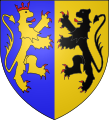 5 January 1477–27 March 1482: Duchess of GueldersDukes of Guelders-House of Wassenberg:The first count of Guelders was Gerard IV, Lord of Wassenberg.During Reginald II's reign, the county of Guelders became a duchy.* before 1096–about 1129 : Gerard I* about 1129–about 1131 : Gerard II the tall, son of...
5 January 1477–27 March 1482: Duchess of GueldersDukes of Guelders-House of Wassenberg:The first count of Guelders was Gerard IV, Lord of Wassenberg.During Reginald II's reign, the county of Guelders became a duchy.* before 1096–about 1129 : Gerard I* about 1129–about 1131 : Gerard II the tall, son of... 5 January 1477–27 March 1482: Duchess of Limburg
5 January 1477–27 March 1482: Duchess of Limburg 5 January 1477–27 March 1482: Duchess of Lothier
5 January 1477–27 March 1482: Duchess of Lothier 5 January 1477–27 March 1482: Duchess of Luxemburg
5 January 1477–27 March 1482: Duchess of Luxemburg 5 January 1477–27 March 1482: Margravine of NamurMarquis of NamurNamur was a county of the Carolingian and later Holy Roman Empire in the Low Countries. Its territories largely correspond with the present-day Belgian arrondissement Namur plus the northwestern part of the arrondissement Dinant....
5 January 1477–27 March 1482: Margravine of NamurMarquis of NamurNamur was a county of the Carolingian and later Holy Roman Empire in the Low Countries. Its territories largely correspond with the present-day Belgian arrondissement Namur plus the northwestern part of the arrondissement Dinant.... 5 January 1477–27 March 1482: Countess Palatine of Burgundy
5 January 1477–27 March 1482: Countess Palatine of Burgundy 5 January 1477–27 March 1482: Countess of ArtoisCounts of ArtoisThe counts of Artois were the rulers over the County of Artois from the 9th century until the abolition of the countship by the French revolutionaries in 1790.-List of Counts of Artois:*Odalric...
5 January 1477–27 March 1482: Countess of ArtoisCounts of ArtoisThe counts of Artois were the rulers over the County of Artois from the 9th century until the abolition of the countship by the French revolutionaries in 1790.-List of Counts of Artois:*Odalric... 5 January 1477–27 March 1482: Countess of Charolais
5 January 1477–27 March 1482: Countess of Charolais 5 January 1477–27 March 1482: Countess of Flanders
5 January 1477–27 March 1482: Countess of Flanders 5 January 1477–27 March 1482: Countess of HainaultCounts of HainautThe counts of Hainaut were the rulers of the county of Hainaut, a historical region in the Low Countries .-House of Reginar:...
5 January 1477–27 March 1482: Countess of HainaultCounts of HainautThe counts of Hainaut were the rulers of the county of Hainaut, a historical region in the Low Countries .-House of Reginar:...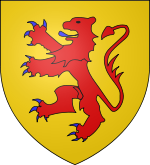 5 January 1477–27 March 1482: Countess of HollandCount of HollandThe Counts of Holland ruled over the County of Holland in the Low Countries between the 10th and the 16th century.-House of Holland:The first count of Holland, Dirk I, was the son or foster-son of Gerolf, Count in Frisia...
5 January 1477–27 March 1482: Countess of HollandCount of HollandThe Counts of Holland ruled over the County of Holland in the Low Countries between the 10th and the 16th century.-House of Holland:The first count of Holland, Dirk I, was the son or foster-son of Gerolf, Count in Frisia... 5 January 1477–27 March 1482: Countess of Zeeland
5 January 1477–27 March 1482: Countess of Zeeland- 5 January 1477–27 March 1482: Countess of ZutphenCount of ZutphenThe title of Count of Zutphen historically belonged to the ruler of the Dutch province of Gelderland ....
See also
- Dukes of Burgundy family treeDukes of Burgundy family treeThis is a family tree of the Dukes of Burgundy, from the 9th century to 1482.Image:BurgundyDukes.pngrect 174 129 324 169 Richard of Autunrect 407 138 521 166 rect 90 189 184 214 Rainier II of Hainautrect 219 189 271 213...
- Other politically important horse accidents
- Duchesse de BourgogneDuchesse de Bourgogne (beer)Duchesse de Bourgogne is a Flanders red ale-style beer produced by Brouwerij Verhaeghe in Vichte, Belgium. After a primary and secondary fermentation, this ale is matured in oak barrels for 18 months. The final product is a blend of a younger 8-month-old beer with an 18-month-old beer...
beer

